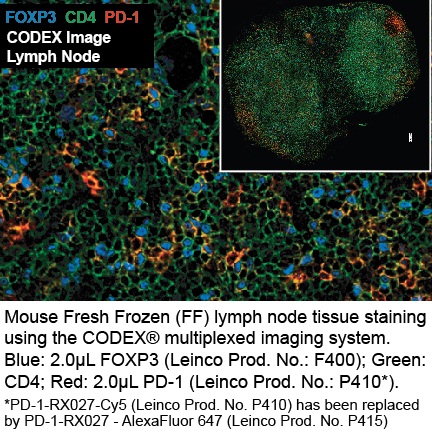Anti-Mouse PD-1-BX027 (RMP1-30); AlexaFluor 647-RX027
| Code | Size | Price |
|---|
| LEI-P415-25Tests | 25 tests | £532.00 |
Quantity:
Prices exclude any Taxes / VAT
Overview
Host Type: Rat
Antibody Isotype: IgG2a κ
Antibody Clonality: Monoclonal
Antibody Clone: RMP1-30
Regulatory Status: RUO
Target Species: Mouse
Applications:
- Immunohistochemistry- Frozen Section (IHC-F)
- Spatial Biology
Storage:
This Phen°Cycler-Fusion (CODEX)® barcoded antibody is stable when stored at 2-8°C for up to 1 year (do not freeze). The CODEX® reporter is stable when frozen at -20°C for up to 1 year.
Images
Further Information
Antigen Distribution:
PD-1 is expressed on a subset of CD4-CD8- thymocytes, and on activated T and B cells.
Conjugate/Tag/Label:
AlexaFluor 647, PhenoCycler®
Format:
This PhenoCycler-Fusion (CODEX)® barcoded antibody is formulated in phosphate buffered saline (150 mM NaCl) PBS, EDTA pH 7.2 containing 0.09% sodium azide as a preservative. The CODEX® reporter is lyophilized and formulated in 1X Tris-EDTA (TE) pH 8.0 (10 mM Tris-HCl, 1 mM disodium EDTA, pH 8.0)
Formulation:
This PhenoCycler-Fusion (CODEX)® barcoded antibody is formulated in phosphate buffered saline (150 mM NaCl) PBS, EDTA pH 7.2 containing 0.09% sodium azide as a preservative. The CODEX® reporter is lyophilized and formulated in 1X Tris-EDTA (TE) pH 8.0 (10 mM Tris-HCl, 1 mM disodium EDTA, pH 8.0)
Immunogen:
Mouse PD-1 transfected BHK cells
Long Description:
Antibody PD-1 is a 50-55 kD member of the B7 Ig superfamily. PD-1 is also a member of the extended CD28/CTLA-4 family of T cell regulators and is suspected to play a role in lymphocyte clonal selection and peripheral tolerance. The ligands of PD-1 are PD-L1 and PD-L2, and are also members of the B7 Ig superfamily. PD-1 and its ligands negatively regulate immune responses. PD-L1, or B7-Homolog 1, is a 40 kD type I transmembrane protein that has been reported to costimulate T cell growth and cytokine production. The interaction of PD-1 with its ligand PD-L1 is critical in the inhibition of T cell responses that include T cell proliferation and cytokine production. PD-L1 has increased expression in several cancers. Inhibition of the interaction between PD-1 and PD-L1 can serve as an immune checkpoint blockade by improving T-cell responses In vitro and mediating preclinical antitumor activity. Within the field of checkpoint inhibition, combination therapy using anti-PD1 in conjunction with anti-CTLA4 has significant therapeutic potential for tumor treatments. PD-L2 is a 25 kD type I transmembrane ligand of PD-1. Via PD-1, PD-L2 can serve as a coinhibitor of T cell functions. Regulation of T cell responses, including enhanced T cell proliferation and cytokine production, can result from mAbs that block the PD-L2 and PD-1 interaction.
PhenoCycler-Fusion (CODEX)® reporters are made up of a fluorescent dye and a short oligonucleotide DNA barcode called a CODEX® Tag. Fluorescent reporters enable highly specific detection of corresponding barcodes, and the use of spectrally separated dyes allow for precise signal detection in up to three distinct fluorescence channels at one time.
NCBI Gene:
18566
Target:
PD-1
References
1. Ardolino, M. et al. (2018) J Clin Invest. 128(10):4654-4668. PubMed
2. Schreiber, RD. et al. (2017) Cancer Immunol Res. 5(2):106-117.
3. Honjo, T. et al. (1992) EMBO J. 11:3887.



